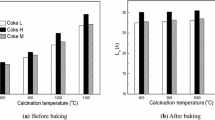Abstract
The correlation between the CO2 reactivity and pore structure of carbon anodes was experimentally investigated. The pore structures of the anodes before and after CO2 oxidation were characterized using image analysis. The porosity, mean pore diameter, and the number of micro-cracks decreased with increasing anode forming pressure, while they increased with over-compaction. With prolonged CO2 oxidation time, the porosity, pore density, mean pore diameter, pore aspect ratio, and the number of micro-cracks increased due to the merging of small pores, increased pore connectivity, and generation of new pores. The activation energy decreased with increasing porosity of the anodes’ pitch phase due to easier CO2 penetration and reaction within the anodes. The results confirm that the fine pitch-coke phase of anodes is preferentially consumed, a cause of carbon dusting. Optimization of the pore structures to balance the pitch, coke, and butt phases may potentially further reduce carbon dusting.






Similar content being viewed by others
References
B. Samanos and C. Dreyer, Light Met. 2001, 681 (2001).
J. Lhuissier, L. Bezamanifary, M. Gendre, and M. Chollier, Light Met. 2009, 979 (2009).
N. Fang, J. Xue, G. Lang, C. Bao, and S. Gao, JOM 68, 635 (2016).
R. Paul, Light Met. 1971, 611 (1971).
J. Boero, Light Met. 1981, 580 (1981).
B. Sadler and S. Algie, Light Met. 1981, 687 (1981).
D. Ziegler, Light Met. 2011, 901 (2011).
F. Chevarin, K. Azari, L. Lemieux, D. Ziegler, M. Fafard, and H. Alamdari, Fuel 178, 93 (2016).
F. Chevarin, L. Lemieux, D. Picard, D. Ziegler, M. Fafard, and H. Alamdaria, Fuel 156, 198 (2015).
D. Ye, J. Agnew, and D. Zhang, Fuel 77, 1209 (1998).
E. Veca and A. Adrover, Fuel 123, 151 (2014).
I. Ahmed and A. Gupta, Appl. Energy 88, 1613 (2011).
P. Li, Q. Yu, H. Xie, and Q. Qin, Energy Fuels 27, 4810 (2013).
T. Popa, M. Fan, and M. Argyle, Fuel 103, 161 (2013).
M. Chan, J. Jones, M. Pourkashanian, and A. Williams, Fuel 78, 1539 (1999).
J. Liao, T. Chen, B. Huang, G. Shi, and X. Xiong, Carbon 40, 617 (2002).
J. Liao, B. Huang, G. Shi, T. Chen, and X. Xiong, Carbon 40, 2483 (2002).
B. Feng and S. Bhatia, Carbon 41, 507 (2003).
X. Xing, R. Harold, G. Zhang, H. Kim, Z. Paul, and O. Oleg, Energy Fuels 30, 161 (2016).
Y. Wang, J. Peng, Y. Di, and N. Feng, Trans. Nonferr. Met. Soc. China 23, 3119 (2013).
S. Lin, M. Hirato, and M. Horio, Fuel 8, 598 (1994).
X. Xing, G. Zhang, D. Mark, C. George, Q. Meng, and O. Oleg, Metall. Mater. Trans. B 44B, 862 (2013).
X. Li, J. Xue, J. Zhu, and Q. Zhang, Light Met. 2012, 1319 (2012).
P. Ehrburger, E. Sanseigne, and B. Tahon, Fuel 23, 1493 (1996).
S. Roervik and H. Oye, Light Met. 1996, 561 (1996).
A. Adams, J. Mathews, and H. Schobert, Light Met. 2002, 547 (2002).
S. Roervik, A. Ratvik, and T. Foosnes, Light Met. 2006, 553 (2006).
X. Huang, D. Kocaefe, D. Bhattacharyay, Y. Kocaefe, and B. Morais, Light Met. 2016, 859 (2016).
J. Patrick, M. Sims, and A. Stacey, J. Microsc. 109, 137 (1977).
J. Xue, M. Han, J. Zhu, L. Feng, and H. Ma, Light Met. 2012, 1229 (2012).
A. Gomez and N. Mahinpey, Chem. Eng. Res. Des. 95, 346 (2015).
S. Vyazovkin and C. Wight, Thermochim. Acta 340, 53 (1999).
R. Luo, Z. Yang, and L. Li, Carbon 38, 109 (2000).
P. Gao, W. Guo, H. Xiao, and J. Guo, Mater. Sci. Eng. A 432, 226 (2006).
Acknowledgements
Supports from the Fundamental Research Funds for Central Universities of China (No. FRF-UM-15-049) and National Natural Science Foundation of China (Nos. 51434005 and 51674025) as well as the assistance of the staff of the Sunstone Research Center, China, are acknowledged.
Author information
Authors and Affiliations
Corresponding author
Rights and permissions
About this article
Cite this article
Chen, T., Xue, J., Lang, G. et al. Dependence of CO2 Reactivity of Carbon Anodes on Pore Structure. JOM 69, 1600–1606 (2017). https://doi.org/10.1007/s11837-017-2324-8
Received:
Accepted:
Published:
Issue Date:
DOI: https://doi.org/10.1007/s11837-017-2324-8




